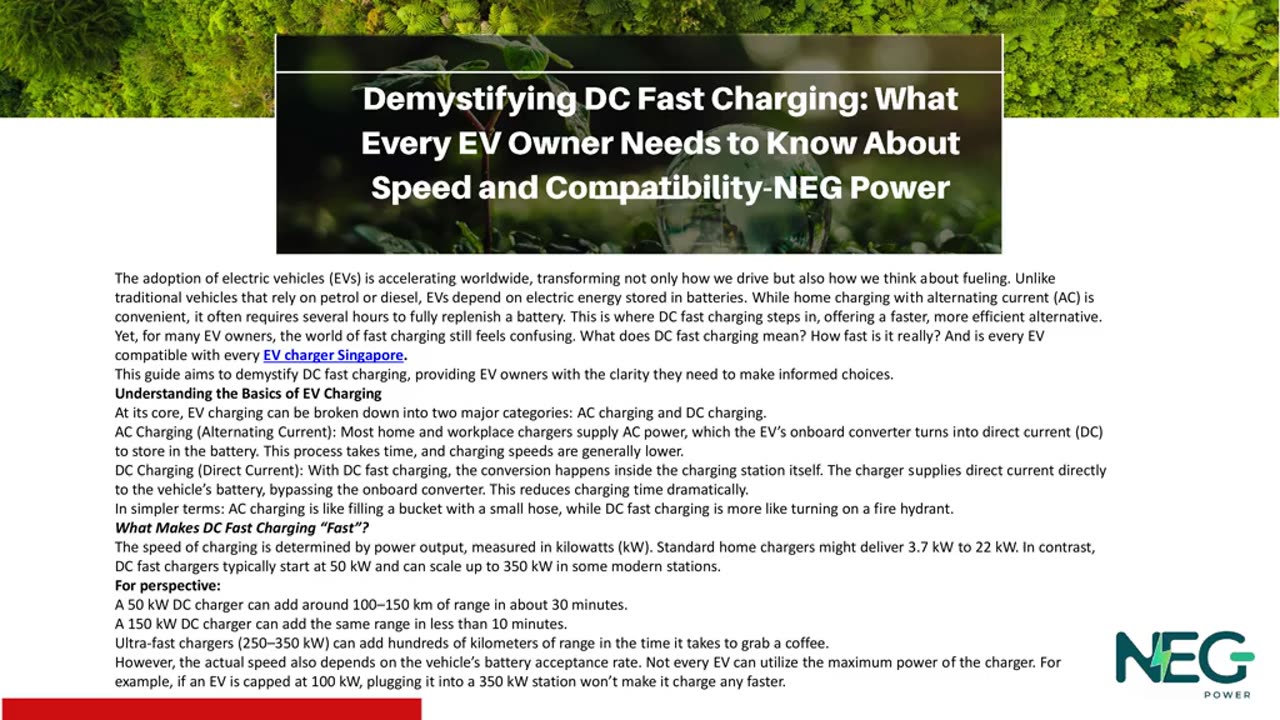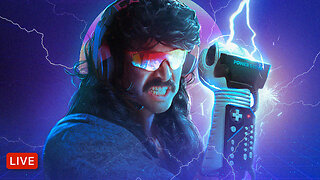Premium Only Content

Demystifying DC Fast Charging: What Every EV Owner Needs to Know About Speed and Compatibility
The adoption of electric vehicles (EVs) is accelerating worldwide, transforming not only how we drive but also how we think about fueling. Unlike traditional vehicles that rely on petrol or diesel, EVs depend on electric energy stored in batteries. While home charging with alternating current (AC) is convenient, it often requires several hours to fully replenish a battery. This is where DC fast charging steps in, offering a faster, more efficient alternative. Yet, for many EV owners, the world of fast charging still feels confusing. What does DC fast charging mean? How fast is it really? And is every EV compatible with every EV charger Singapore.
This guide aims to demystify DC fast charging, providing EV owners with the clarity they need to make informed choices.
Understanding the Basics of EV Charging
At its core, EV charging can be broken down into two major categories: AC charging and DC charging.
AC Charging (Alternating Current): Most home and workplace chargers supply AC power, which the EV’s onboard converter turns into direct current (DC) to store in the battery. This process takes time, and charging speeds are generally lower.
DC Charging (Direct Current): With DC fast charging, the conversion happens inside the charging station itself. The charger supplies direct current directly to the vehicle’s battery, bypassing the onboard converter. This reduces charging time dramatically.
In simpler terms: AC charging is like filling a bucket with a small hose, while DC fast charging is more like turning on a fire hydrant.
What Makes DC Fast Charging “Fast”?
The speed of charging is determined by power output, measured in kilowatts (kW). Standard home chargers might deliver 3.7 kW to 22 kW. In contrast, DC fast chargers typically start at 50 kW and can scale up to 350 kW in some modern stations.
For perspective:
A 50 kW DC charger can add around 100–150 km of range in about 30 minutes.
A 150 kW DC charger can add the same range in less than 10 minutes.
Ultra-fast chargers (250–350 kW) can add hundreds of kilometers of range in the time it takes to grab a coffee.
However, the actual speed also depends on the vehicle’s battery acceptance rate. Not every EV can utilize the maximum power of the charger. For example, if an EV is capped at 100 kW, plugging it into a 350 kW station won’t make it charge any faster.
Compatibility: Why Not All EVs Charge the Same Way
Compatibility is one of the biggest concerns for EV owners. While it would be convenient if every EV worked with every EV charger, the reality is more complex. The following factors determine whether your vehicle can benefit from a particular DC fast charger:
Maximum Charging Capacity of the Vehicle
Even if you plug into a 350 kW station, your car might only accept 100 kW. This limitation comes from the vehicle’s internal systems, not the charger.
Battery State of Charge (SoC)
Charging speeds aren’t consistent from 0% to 100%. Most EVs charge fastest between 20% and 80%. As the battery nears full capacity, charging slows down to protect battery health.
Thermal Management
Battery temperature also impacts compatibility. If the battery gets too hot or cold, the car’s system may throttle charging speed.
Key Benefits of DC Fast Charging
Time Efficiency
The primary benefit is speed. Long road trips become feasible without waiting hours to recharge.
Convenience for Urban Living
For EV owners who live in apartments or homes without dedicated charging setups, public DC fast charging provides a practical alternative.
Encouraging EV Adoption
As public charging networks expand, the fear of “range anxiety” diminishes, making EV ownership more attractive.
Challenges and Considerations
While DC fast charging is a game-changer, it comes with considerations EV owners should understand.
Battery Health
Repeated use of DC fast charging can cause faster degradation of battery cells compared to slower AC charging. Automakers often recommend using fast charging occasionally rather than daily.
Cost
DC fast charging is generally more expensive than home charging. Many networks charge per kWh, per minute, or a combination of both.
Infrastructure Availability
Not all areas have robust DC fast charging networks. While urban and highway corridors are rapidly being covered, rural locations may still lag behind.
Compatibility Confusion
As mentioned earlier, not every EV charger in Singapore works with every EV. This can cause frustration for new EV owners unfamiliar with connector types and maximum vehicle acceptance rates.
The Future of DC Fast Charging
The landscape of EV charging is evolving rapidly, with several trends shaping the future:
Ultra-Fast Charging Networks
Companies are investing heavily in 250–350 kW networks. These stations will make long distance EV travel almost indistinguishable from traditional refueling.
Vehicle-to-Grid (V2G) Integration
Future chargers may not only replenish batteries but also allow EVs to feed energy back into the grid, improving energy efficiency and sustainability.
Wireless Charging
Research is underway into inductive DC fast charging, which would eliminate the need for cables altogether.
Standardization Efforts
Governments and industry groups are working toward universal standards for connectors and protocols, which will reduce compatibility issues over time.
How EV Owners Can Make the Most of DC Fast Charging
Plan Ahead
Use charging apps and navigation systems that highlight compatible charging stations along your route.
Know Your Vehicle’s Limits
Understanding your car’s maximum charging capacity ensures you set realistic expectations when using a high-power EV charger.
Charge Smart
Aim to charge between 20% and 80% for efficiency and battery health. Avoid letting your battery drain to near zero or charging to 100% at fast chargers unless necessary.
Balance Costs
Use home charging for daily needs and rely on DC fast charging for long trips. This helps manage expenses while preserving battery longevity.
Conclusion
DC fast charging is one of the most significant advancements in EV infrastructure, helping bridge the gap between convenience and practicality. By delivering high power directly to the battery, it reduces charging time drastically compared to traditional AC methods. However, understanding factors like compatibility, connector types, and your vehicle’s acceptance limits is essential to get the most out of any EV charger Singapore.
For EV owners, knowledge is power. By learning how DC fast charging works, where to use it, and when to rely on it, drivers can enjoy the freedom of electric mobility without anxiety. As infrastructure expands and technology advances, the experience will only become smoother, faster, and more accessible. The future of driving is electric — and DC fast charging is at the heart of making it a reality.
Visits us : https://www.negpower.sg/
-
 14:37
14:37
Bearing
9 hours agoHasan Piker on Charlie Kirk’s “Dangerous Ideas” 💥 Just a LARPER Bro 😂
4.54K16 -
 1:31:13
1:31:13
The Quartering
4 hours agoColbert Rages Over Kimmel, Antifa Attacks Charlie Kirk Vigil & Raja Jackson Arrested Finally
177K65 -
 LIVE
LIVE
Dr Disrespect
6 hours ago🔴LIVE - DR DISRESPECT - SUPER ENTERTAINMENT POWER
1,098 watching -
![MAHA News [9.19] McDonalds & Tyson Get Healthier, Big Pharma Ads, CDC Updates Vax Sched](https://1a-1791.com/video/fww1/5d/s8/1/4/u/s/j/4usjz.0kob-small-MAHA-News-9.19.jpg) DVR
DVR
Badlands Media
13 hours agoMAHA News [9.19] McDonalds & Tyson Get Healthier, Big Pharma Ads, CDC Updates Vax Sched
21.8K2 -
 1:04:41
1:04:41
Ben Shapiro
5 hours agoEp. 2284 - THE DAY AFTER: Kimmel Suspended, Democrats LIVID
64.5K75 -
 1:57:22
1:57:22
The Charlie Kirk Show
5 hours agoTucker Carlson on the Faith of Charlie Kirk | 9.19.2025
178K142 -
 2:21:46
2:21:46
Lara Logan
9 hours agoTHE FIGHT FOR A FREE BRITAIN with Katie Hopkins | Episode 36 | Going Rogue with Lara Logan
54.8K28 -
 1:05:14
1:05:14
Jeff Ahern
3 hours ago $1.00 earnedFriday Freak out with Jeff Ahern
24.3K -
 16:52
16:52
IsaacButterfield
12 hours ago $1.22 earnedWoke Karens Are Trying to End This Man’s Career
32.9K10 -
 4:09:14
4:09:14
The Bubba Army
1 day agoRaja Jackson Arrested! - Bubba the Love Sponge® Show | 9/19/25
51.4K3